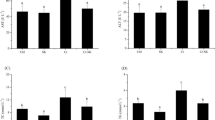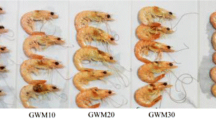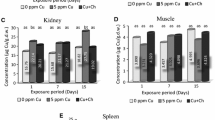Abstract
Toxic heavy metals such as cadmium (Cd) accuulate in cultured fish from solid-form feed mixtures. In this paper, two natural ingredients, supposed to inhibit accumulation of heavy metals in the fish body, were investigated to develop a functional feed mixture for healthy fish. Three test diets: (i) #1, regular diet as negative control; (ii) #2, #1 +2% lyophilized Chinese parsley Coriandrum sativum (CP); and (iii) #3, #1 +3% chitosan (CT), were each fed to 50 rainbow trout Oncorhynchus mykiss once a day, at the constantrate of 1.0–1.2% of body weight for 12 weeks. No undesirable effect on fish growth was observed by an addition of either CP or CT to regular feed. Then, 10 mg Cd was added to 1 kg each of the three test diets and they were named as: (i) #4, #1 +Cd; (ii) #5, #2 +Cd; and (iii) #6, #3 +Cd, respectively. The fish given positive a control feed (diet #4) for 3 weeks accumulated Cd in the liver and kidney at approximately 0.52 mg/kg. However, Cd in ordinary muscle was found to be just above the detection limit. Upon accumulation of Cd, three groups of 50 fish were each fed test diets #4, #5, and #6 for 12 weeks at the same feed rate described above. The concentrations of Cd accumulated in the liver, kidney, and ordinary muscle of the fish were measured every 3 weeks. Contrary to the positive control fish fed diet #4, those fish fed test diets #5 and #6 accumulated 20–30% and 25–40% less Cd in the liver, respectively. Test diets were a little less effective for inhibition of Cd uptake in the kidney than that observed in the liver. These results suggest that addition of CP or CT to fish feed might be used to decrease toxic heavy metal accumulation in fish.
Similar content being viewed by others
References
Food and Agriculture Organization of the United Nations. World review of fisheries and aquaculture. Fisheries resources: trends in production, utilization and trade [Cited 23 December 2004.] Available from URL: http://www.fao.org/documents/show_crl.asp? url_file=/docrep/005/y7300e/y7300e04.htm 2004; 3–52.
Ministry of Agriculture, Forestry and Fisheries. Japanese Fisheries and Aquaculture Production Annual Statistics for 1999. Association of Agriculture and Forestry Statistics, Tokyo. 2001; 326 (in Japanese).
Watanabe T, Aoki H, Watanabe K, Maita M, Satoh S. Quality evaluation of different types of non-fishmeal diets for yellowtail. Fish. Sci. 2001; 67: 461–446.
Aoki H, Sanada Y, Furuichi M, Kimoto R, Maita M, Akimoto A, Yamagata Y, Watanabe T. Partial or complete replacement of fish meal by alternate protein sources in diet for yellowtail and red sea bream. Suisanzoshoku 2000; 48: 53–63.
Daly JM, Reynolds J, Sigal RK, Shou J, Liberman MD. Effect of dietary protein and amino acids on immune function. Crit Care Med. 1990; 18: 86–93.
Ministry of Agriculture Forestry and Fisheries. Official report on residual toxic substances distributed in fish feed. Approaches for Establishment of the Limit for Toxic Substances (draft report on the project for emergency plan). Hisheries Agency, Tokyo. 2002; 1–56 (in Japanese).
Ministry of Agriculture, Forestry and Fisheries. Press release by the Agricultural Production Bureau, on December 14 and 25, 2002 [Cited 27 August 2005.] Available from URL: http://www.maff.go.jp/www/press/cont/ 20021225press_4.html2002.
Aga M, Iwaki K, Ueda Y, Ushio S, Masaki N, Fukuda S, Kimoto T, Ikeda M, Kurimoto M. Preventive effect of Coriandrum sativum (Chinese parsley) on localized lead deposition in ICR mice. J. Ethnopharmacol. 2001; 77: 203–208.
Selmer-Olsena E, Ratnaweerab HC, Pehrson R. A novel treatment process for dairy wastewater with chitosan produced from shrimp-shell waste. Water Sci. Technol. 1996; 34: 33–40.
Evans JR, Davids WG, MacRae JD, Amirbahman A. Kinetics of cadmium uptake by chitosan-based crab shells. Water Res. 2002; 36: 3219–3226.
Krajewska B. Application of chitin- and chitosan-based materials for enzyme immobilizations: a review. Enzyme Microb. Tech. 2004; 35: 126–139.
World Health Organization of the United Nations. Evaluation of Certain Food Additives and Contaminants (41st Report of the Joint FAO/WHO Expert Committee on Food Additives). WHO Technical Report Series, No. 837. World Health Organization, Geneva, 1993.
Nordberg G. Excursions of intake above ADI: case study on cadmium. Regul. Toxicol. Pharm. 1999; 30: 57–22.
Hayashi T, Ren HF, Yasui M. inventors. Tokyo University of Marine Science and Technology and Shizuoka Prefecture Fisheries Experiment Station, assignees. Functional animal feeding stuff. Japanese patent JP: 2004-75786. 2004: March 17.
Aga M, Iwaki K, Ushio S, Masaki N, Fukuda S, Kurimoto M, Ikeda M. Preventive effect of Coriandrum sativum (Chinese parsley) on aluminum deposition in ICR Mice. Natural Med. 2002; 56: 187–190.
Hensbergen PJ, van Velzen MJM, Nugroho RA, Donker MH, van Straalen NM. Metallothionein-bound cadmium in the gut of the insect Orchesella cincta (Collembola) in relation to dietary cadmium exposure. Comp. Biochem. Phys. (C). 2000; 125: 17–24.
Xie W, Xu P, Liu Q. Antioxidant activity of water-soluble chitosan derivatives. Bioorg. Med. Chem. Lett. 2001; 11: 1699–1701.
Jeon TI, Hwang SG, Park NG, Jung YR, Shin SI, Choi SD, Park DK. Antioxidative effect of chitosan on chronic carbon tetrachloride induced hepatic injury in rats. Toxicology. 2003; 187: 67–73.
Pan JR, Huang C, Chen S, Chung YC. Evaluation of a modified chitosan biopolymer for coagulation of colloidal particles. Colloids Surf. A: Physicochem. Engineer. Aspect. 1999; 147: 359–364.
Author information
Authors and Affiliations
Corresponding author
Rights and permissions
About this article
Cite this article
Ren, H., Jia, H., Kim, S. et al. Effect of chinese parsley Coriandrum sativum and chitosan on inhibiting the accumulation of cadmium in cultured rainbow trout Oncorhynchus mykiss . Fish Sci 72, 263–269 (2006). https://doi.org/10.1111/j.1444-2906.2006.01147.x
Received:
Accepted:
Issue Date:
DOI: https://doi.org/10.1111/j.1444-2906.2006.01147.x




